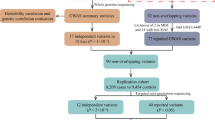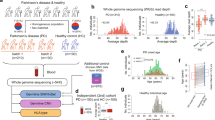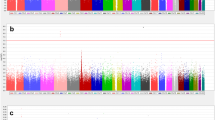Abstract
In view of the population-specific heterogeneity in reported genetic risk factors for Parkinson's disease (PD), we conducted a genome-wide association study (GWAS) in a large sample of PD cases and controls from the Netherlands. After quality control (QC), a total of 514 799 SNPs genotyped in 772 PD cases and 2024 controls were included in our analyses. Direct replication of SNPs within SNCA and BST1 confirmed these two genes to be associated with PD in the Netherlands (SNCA, rs2736990: P=1.63 × 10−5, OR=1.325 and BST1, rs12502586: P=1.63 × 10−3, OR=1.337). Within SNCA, two independent signals in two different linkage disequilibrium (LD) blocks in the 3′ and 5′ ends of the gene were detected. Besides, post-hoc analysis confirmed GAK/DGKQ, HLA and MAPT as PD risk loci among the Dutch (GAK/DGKQ, rs2242235: P=1.22 × 10−4, OR=1.51; HLA, rs4248166: P=4.39 × 10−5, OR=1.36; and MAPT, rs3785880: P=1.9 × 10−3, OR=1.19).
Similar content being viewed by others
Log in or create a free account to read this content
Gain free access to this article, as well as selected content from this journal and more on nature.com
or
References
Burn DJ, Mark MH, Playford ED et al: Parkinson's disease in twins studied with 18F-dopa and positron emission tomography. Neurology 1992; 42: 1894–1900.
Piccini P, Morrish PK, Turjanski N et al: Dopaminergic function in familial Parkinson's disease: a clinical and 18F-dopa positron emission tomography study. Ann Neurol 1997; 41: 222–229.
Piccini P, Burn DJ, Ceravolo R, Maraganore D, Brooks DJ : The role of inheritance in sporadic Parkinson's disease: evidence from a longitudinal study of dopaminergic function in twins. Ann Neurol 1999; 45: 577–582.
Pirkevi C, Lesage S, Brice A, Basak AN : From genes to proteins in mendelian Parkinson's disease: an overview. Anat Rec (Hoboken) 2009; 292: 1893–1901.
Pankratz N, Wilk JB, Latourelle JC et al: Genomewide association study for susceptibility genes contributing to familial Parkinson disease. Hum Genet 2009; 124: 593–605.
Satake W, Nakabayashi Y, Mizuta I et al: Genome-wide association study identifies common variants at four loci as genetic risk factors for Parkinson's disease. Nat Genet 2009; 41: 1303–1307.
Simon-Sanchez J, Schulte C, Bras JM et al: Genome-wide association study reveals genetic risk underlying Parkinson's disease. Nat Genet 2009; 41: 1308–1312.
The UK Parkinson's Disease Consortium and The Wellcome Trust Case Control Consortium 2: Dissection of the genetics of Parkinson's disease identifies an additional association 5′ of SNCA and multiple associated haplotypes at 7q21. Hum Mol Genet 2011; 20: 345–353.
Edwards TL, Scott WK, Almonte C et al: Genome-wide association study confirms SNPs in SNCA and the MAPT region as common risk factors for Parkinson disease. Ann Hum Genet 2010; 74: 97–109.
Hamza TH, Zabetian CP, Tenesa A et al: Common genetic variation in the HLA region is associated with late-onset sporadic Parkinson's disease. Nat Genet 2010; 42: 781–785.
Saad M, Lesage S, Saint-Pierre A et al: Genome-wide association study confirms BST1 and suggests a locus on 12q24 as risk loci for Parkinson′s disease in the European population. Hum Mol Genet 2011; 20: 615–627.
Hofman A, Grobbee DE, de Jong PT, van den Ouweland FA : Determinants of disease and disability in the elderly: the Rotterdam Elderly Study. Eur J Epidemiol 1991; 7: 403–422.
Hofman A, Breteler MM, van Duijn CM et al: The Rotterdam Study: objectives and design update. Eur J Epidemiol 2007; 22: 819–829.
Hofman A, Breteler MM, van Duijn CM et al: The Rotterdam Study: 2010 objectives and design update. Eur J Epidemiol 2009; 24: 553–572.
Purcell S, Neale B, Todd-Brown K et al: PLINK: a tool set for whole-genome association and population-based linkage analyses. Am J Hum Genet 2007; 81: 559–575.
Barrett JC, Fry B, Maller J, Daly MJ : Haploview: analysis and visualization of LD and haplotype maps. Bioinformatics 2005; 21: 263–265.
Gabriel SB, Schaffner SF, Nguyen H et al: The structure of haplotype blocks in the human genome. Science 2002; 296: 2225–2229.
Stefansson H, Helgason A, Thorleifsson G et al: A common inversion under selection in Europeans. Nat Genet 2005; 37: 129–137.
Golbe LI, Lazzarini AM, Spychala JR et al: The tau A0 allele in Parkinson's disease. Mov Disord 2001; 16: 442–447.
Maraganore DM, Hernandez DG, Singleton AB et al: Case-control study of the extended tau gene haplotype in Parkinson's disease. Ann Neurol 2001; 50: 658–661.
Skipper L, Wilkes K, Toft M et al: Linkage disequilibrium and association of MAPT H1 in Parkinson disease. Am J Hum Genet 2004; 75: 669–677.
Zhang J, Song Y, Chen H, Fan D : The tau gene haplotype h1 confers a susceptibility to Parkinson's disease. Eur Neurol 2005; 53: 15–21.
Zabetian CP, Hutter CM, Factor SA et al: Association analysis of MAPT H1 haplotype and subhaplotypes in Parkinson's disease. Ann Neurol 2007; 62: 137–144.
Tobin JE, Latourelle JC, Lew MF et al: Haplotypes and gene expression implicate the MAPT region for Parkinson disease: the GenePD Study. Neurology 2008; 71: 28–34.
Mueller JC, Fuchs J, Hofer A et al: Multiple regions of alpha-synuclein are associated with Parkinson's disease. Ann Neurol 2005; 57: 535–541.
Maraganore DM, de Andrade M, Elbaz A et al: Collaborative analysis of alpha-synuclein gene promoter variability and Parkinson disease. JAMA 2006; 296: 661–670.
Mizuta I, Satake W, Nakabayashi Y et al: Multiple candidate gene analysis identifies alpha-synuclein as a susceptibility gene for sporadic Parkinson's disease. Hum Mol Genet 2006; 15: 1151–1158.
Winkler S, Hagenah J, Lincoln S et al: Alpha-synuclein and Parkinson disease susceptibility. Neurology 2007; 69: 1745–1750.
Kay DM, Factor SA, Samii A et al: Genetic association between alpha-synuclein and idiopathic Parkinson's disease. Am J Med Genet B Neuropsychiatr Genet 2008; 147B: 1222–1230.
Myhre R, Toft M, Kachergus J et al: Multiple alpha-synuclein gene polymorphisms are associated with Parkinson's disease in a Norwegian population. Acta Neurol Scand 2008; 118: 320–327.
Rajput A, Vilarino-Guell C, Rajput ML et al: Alpha-synuclein polymorphisms are associated with Parkinson's disease in a Saskatchewan population. Mov Disord 2009; 24: 2411–2414.
Sotiriou S, Gibney G, Baxevanis AD, Nussbaum RL : A single nucleotide polymorphism in the 3′UTR of the SNCA gene encoding alpha-synuclein is a new potential susceptibility locus for Parkinson disease. Neurosci Lett 2009; 461: 196–201.
Izumi Y, Morino H, Oda M et al: Genetic studies in Parkinson's disease with an alpha-synuclein/NACP gene polymorphism in Japan. Neurosci Lett 2001; 300: 125–127.
Khan N, Graham E, Dixon P et al: Parkinson's disease is not associated with the combined alpha-synuclein/apolipoprotein E susceptibility genotype. Ann Neurol 2001; 49: 665–668.
Holzmann C, Kruger R, Saecker AM et al: Polymorphisms of the alpha-synuclein promoter: expression analyses and association studies in Parkinson's disease. J Neural Transm 2003; 110: 67–76.
Spadafora P, Annesi G, Pasqua AA et al: NACP-REP1 polymorphism is not involved in Parkinson's disease: a case-control study in a population sample from southern Italy. Neurosci Lett 2003; 351: 75–78.
Tan EK, Chai A, Teo YY et al: Alpha-synuclein haplotypes implicated in risk of Parkinson's disease. Neurology 2004; 62: 128–131.
Farrer M, Maraganore DM, Lockhart P et al: alpha-Synuclein gene haplotypes are associated with Parkinson's disease. Hum Mol Genet 2001; 10: 1847–1851.
Pals P, Lincoln S, Manning J et al: alpha-Synuclein promoter confers susceptibility to Parkinson's disease. Ann Neurol 2004; 56: 591–595.
Chiba-Falek O, Nussbaum RL : Effect of allelic variation at the NACP-Rep1 repeat upstream of the alpha-synuclein gene (SNCA) on transcription in a cell culture luciferase reporter system. Hum Mol Genet 2001; 10: 3101–3109.
Cronin KD, Ge D, Manninger P et al: Expansion of the Parkinson disease-associated SNCA-Rep1 allele upregulates human alpha-synuclein in transgenic mouse brain. Hum Mol Genet 2009; 18: 3274–3285.
Linnertz C, Saucier L, Ge D et al: Genetic regulation of alpha-synuclein mRNA expression in various human brain tissues. PLoS One 2009; 4: e7480.
Seldin MF, Shigeta R, Villoslada P et al: European population substructure: clustering of northern and southern populations. PLoS Genet 2006; 2: e143.
Moskvina V, Smith M, Ivanov D et al: Genetic differences between five European populations. Hum Hered 2010; 70: 141–149.
Price AL, Butler J, Patterson N et al: Discerning the ancestry of European Americans in genetic association studies. PLoS Genet 2008; 4: e236.
McGeer PL, Itagaki S, Boyes BE, McGeer EG : Reactive microglia are positive for HLA-DR in the substantia nigra of Parkinson's and Alzheimer's disease brains. Neurology 1988; 38: 1285–1291.
Hirsch EC, Hunot S : Neuroinflammation in Parkinson's disease: a target for neuroprotection? Lancet Neurol 2009; 8: 382–397.
Rugbjerg K, Friis S, Ritz B, Schernhammer ES, Korbo L, Olsen JH : Autoimmune disease and risk for Parkinson disease: a population-based case-control study. Neurology 2009; 73: 1462–1468.
Kaisho T, Ishikawa J, Oritani K et al: BST-1, a surface molecule of bone marrow stromal cell lines that facilitates pre-B-cell growth. Proc Natl Acad Sci USA 1994; 91: 5325–5329.
Hrycaj P, Korczowska I, Lacki JK : Severe Parkinson's disease in rheumatoid arthritis patient treated with infliximab. Rheumatology (Oxford) 2003; 42: 702–703.
Melikoglu MA, Sezer I, Kacar C : Rheumatoid-like hand deformities in Parkinson disease. J Clin Rheumatol 2007; 13: 236–237.
Kogure T, Tatsumi T, Kaneko Y, Okamoto K : Rheumatoid arthritis accompanied by Parkinson disease. J Clin Rheumatol 2008; 14: 192–193.
Emile J, Truelle JL, Pouplard A, Hurez D : Association of Parkinson's disease with HLA-B17 and B18 antigens. Nouv Presse Med 1977; 6: 4144.
Elizan TS, Terasaki PI, Yahr MD : HLA-B14 antigen and postencephalitic Parkinson's disease. Their association in an American-Jewish ethnic group. Arch Neurol 1980; 37: 542–544.
Lampe JB, Gossrau G, Herting B et al: HLA typing and Parkinson's disease. Eur Neurol 2003; 50: 64–68.
Chen H, Zhang SM, Hernan MA et al: Nonsteroidal anti-inflammatory drugs and the risk of Parkinson disease. Arch Neurol 2003; 60: 1059–1064.
Esposito E, Di Matteo V, Benigno A, Pierucci M, Crescimanno G, Di Giovanni G : Non-steroidal anti-inflammatory drugs in Parkinson's disease. Exp Neurol 2007; 205: 295–312.
McGeer PL, Schwab C, Parent A, Doudet D : Presence of reactive microglia in monkey substantia nigra years after 1-methyl-4-phenyl-1,2,3,6-tetrahydropyridine administration. Ann Neurol 2003; 54: 599–604.
Barcia C, Sanchez Bahillo A, Fernandez-Villalba E et al: Evidence of active microglia in substantia nigra pars compacta of parkinsonian monkeys 1 year after MPTP exposure. Glia 2004; 46: 402–409.
Gao HM, Hong JS, Zhang W, Liu B : Distinct role for microglia in rotenone-induced degeneration of dopaminergic neurons. J Neurosci 2002; 22: 782–790.
Lee DY, Oh YJ, Jin BK : Thrombin-activated microglia contribute to death of dopaminergic neurons in rat mesencephalic cultures: dual roles of mitogen-activated protein kinase signaling pathways. Glia 2005; 51: 98–110.
Wang XJ, Yan ZQ, Lu GQ, Stuart S, Chen SD : Parkinson disease IgG and C5a-induced synergistic dopaminergic neurotoxicity: role of microglia. Neurochem Int 2007; 50: 39–50.
Zhang W, Wang T, Pei Z et al: Aggregated alpha-synuclein activates microglia: a process leading to disease progression in Parkinson′s disease. FASEB J 2005; 19: 533–542.
Grunblatt E, Mandel S, Jacob-Hirsch J et al: Gene expression profiling of parkinsonian substantia nigra pars compacta; alterations in ubiquitin-proteasome, heat shock protein, iron and oxidative stress regulated proteins, cell adhesion/cellular matrix and vesicle trafficking genes. J Neural Transm 2004; 111: 1543–1573.
Fung HC, Xiromerisiou G, Gibbs JR et al: Association of tau haplotype-tagging polymorphisms with Parkinson's disease in diverse ethnic Parkinson's disease cohorts. Neurodegener Dis 2006; 3: 327–333.
Vandrovcova J, Pittman AM, Malzer E et al: Association of MAPT haplotype-tagging SNPs with sporadic Parkinson's disease. Neurobiol Aging 2009; 30: 1477–1482.
Acknowledgements
We thank the subjects involved in this study for making this work possible. We also want to thank the Hersenstichting Nederland (http://www.hersenstichting.nl), the Neuroscience Campus Amsterdam and the section of Medical genomics (MGA) and the Intramural Research Program of the National Institute on Aging (National Institutes of Health, Department of Health and Human services; project number Z01 AG000949-04) for supporting in part the work presented here. Last, we would like to thank the Prinses Beatrix Fonds (http://www.prinsesbeatrixfonds.nl) for sponsoring this work.
Author information
Authors and Affiliations
Corresponding author
Ethics declarations
Competing interests
The authors declare no conflict of interest.
Additional information
Supplementary Information accompanies the paper on European Journal of Human Genetics website
Supplementary information
Rights and permissions
About this article
Cite this article
Simón-Sánchez, J., van Hilten, J., van de Warrenburg, B. et al. Genome-wide association study confirms extant PD risk loci among the Dutch. Eur J Hum Genet 19, 655–661 (2011). https://doi.org/10.1038/ejhg.2010.254
Received:
Revised:
Accepted:
Published:
Issue date:
DOI: https://doi.org/10.1038/ejhg.2010.254
Keywords
This article is cited by
-
Vesicle trafficking and lipid metabolism in synucleinopathy
Acta Neuropathologica (2021)
-
Association study of MCCC1/LAMP3 and DGKQ variants with Parkinson’s disease in patients of Malay ancestry
Neurological Sciences (2021)
-
Genetic predispositions of Parkinson’s disease revealed in patient-derived brain cells
npj Parkinson's Disease (2020)
-
Parkinson’s disease: proteinopathy or lipidopathy?
npj Parkinson's Disease (2020)
-
Reprogramming fatty acyl specificity of lipid kinases via C1 domain engineering
Nature Chemical Biology (2020)



